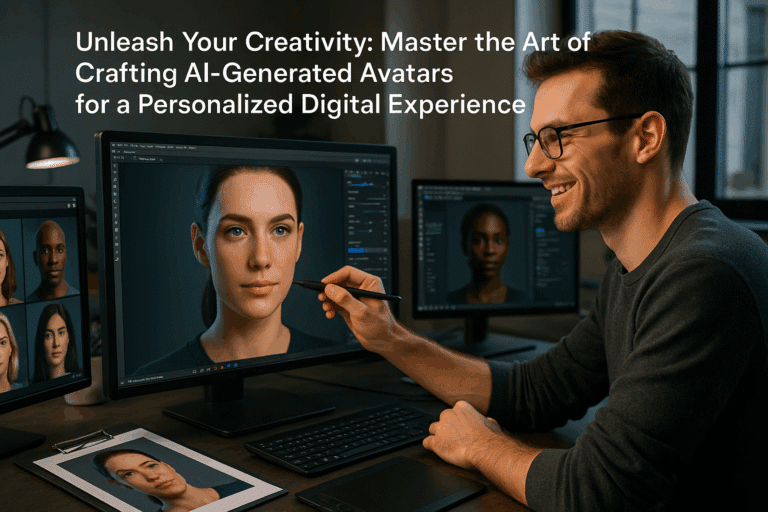Among the many fascinating offshoots of this AI revolution is the advent of AI-generated imagery. AI’s ability to create visually compelling and highly realistic images has opened up new vistas for innovation. However, it also raises important questions about the ethical implications of such technology. What happens when AI-generated images blur the line between reality and fabrication, or when they’re used in ways that violate privacy or misrepresent the truth? 🤔
These questions are becoming increasingly pertinent as AI-generated imagery becomes more prevalent. Today, it’s used in everything from virtual reality gaming and film production to social media filters and news broadcasting. With the power to create, alter, and disseminate images at an unprecedented scale, AI offers incredible possibilities for creativity and innovation. However, it also carries potential risks for misuse and abuse.🚧
And so, we find ourselves navigating the fine line between innovation and integrity, trying to harness the benefits of AI-generated imagery while mitigating its potential harms. This blog post aims to unpack this complex issue, exploring the ethical dimensions of AI-generated imagery and offering insights on how to manage them effectively.🗺️
The Power of AI-Generated Imagery
First, we’ll delve into the world of AI-generated imagery, examining the technology behind it and its diverse applications. We’ll look at how AI algorithms generate images, the different types of AI-generated imagery, and some of the innovative ways it’s being used in various industries.🖼️🔬
The Ethical Implications of AI-Generated Imagery
Next, we’ll turn our attention to the ethical implications of AI-generated imagery. We’ll explore concerns about privacy and consent, issues of authenticity and truth, and the potential for AI-generated images to perpetuate bias or misinformation. Through case studies and expert opinions, we’ll probe the ethical dilemmas that arise from the use of AI in image generation.🧭⚖️
Navigating the Fine Line Between Innovation and Integrity
Finally, we’ll offer insights on how to navigate the fine line between innovation and integrity when using AI-generated imagery. We’ll provide practical strategies for ensuring ethical usage, including transparency, accountability, and respect for individuals’ rights. We’ll also discuss the role of policies and regulations in guiding ethical practices, and the importance of fostering a culture of integrity within the AI industry.🔑🌐
In this exploration, we won’t shy away from the challenging questions or the hard truths. We’ll engage with the complexities and contradictions inherent in this technology, and we won’t settle for easy answers. Instead, we’ll strive for a nuanced understanding of AI-generated imagery, one that acknowledges both its potential and its pitfalls, and that provides a roadmap for ethical engagement.🕵️♂️💡
So, whether you’re a software engineer, a digital artist, a policy maker, or simply an interested observer, we invite you to join us on this journey. As we unveil the ethical implications of AI-generated imagery, we believe you’ll gain a deeper appreciation for this remarkable technology – and for the vital importance of navigating the fine line between innovation and integrity.🚀🎯
Let’s dive in! 🏊♂️
Decoding the Magic of AI-Generated Imagery: A Technical Perspective
Artificial Intelligence (AI) has infiltrated almost every sector of life, from healthcare to finance, education to entertainment. The sphere of digital imagery is no exception. AI has become a crucial tool in the creation, modification, and interpretation of digital images. This article delves deep into the technological specifics of AI-generated imagery, revealing how it works and how it’s transforming industries. But first, let’s clarify what AI-generated imagery is.
AI-generated imagery refers to the use of machine learning algorithms to create or modify digital images. The AI software can generate realistic images from scratch or transform existing ones, creating effects that would be difficult or impossible to achieve manually. To understand this better, consider the video titled “How AI Can Generate Realistic Images” on the YouTube channel Two Minute Papers. It provides an insightful overview of the topic.
Now, having understood the basics, let’s dive into the technicalities. The cornerstone of AI-generated imagery is a category of machine learning called deep learning. Deep learning models, specifically a variant known as Generative Adversarial Networks (GANs), have shown remarkable results in the field of AI imagery.
Generative Adversarial Networks (GANs) and AI Imagery
GANs consist of two main components: a generator and a discriminator. The generator creates images, and the discriminator evaluates them, providing feedback to the generator. Through this iterative process, the generator improves its capacity to create realistic images. To visualize this complex process, consider watching the YouTube video “Generative Adversarial Networks (GANs) Explained” by the channel 3Blue1Brown.
GANs have revolutionized digital image generation, enabling the creation of hyper-realistic images. They have found applications in numerous fields, including fashion, where AI can design new clothing items; medicine, where it can generate images of human organs for study or diagnosis; and entertainment, where it can create realistic characters for video games or movies.
However, despite their innovative potential, GANs also have controversial aspects. One of them is the ethical implications of their use, which leads us to the next section of our exploration.
Exploring the Ethical Gray Areas of AI-Generated Imagery
While AI-generated imagery brings immense potential for innovation, it also introduces new ethical dilemmas. For instance, consider the use of AI in creating deepfakes—hyper-realistic fake videos or images that make it appear as though a person is doing or saying something they didn’t. These can be used to spread misinformation, slander individuals, or manipulate public opinion, raising serious ethical concerns.
Another ethical issue stems from the use of AI to generate synthetic media, such as AI-generated faces. These are used in a variety of applications, from online advertising to creating characters for video games. However, they also raise questions about consent, privacy, and the authenticity of digital content.
To understand these ethical implications more comprehensively, consider referring to the table below comparing different ethical aspects of AI-generated imagery:
| Aspect | Ethical Implications |
|---|---|
| Creation of Deepfakes | Potential to spread misinformation and manipulate public opinion; privacy concerns |
| Synthetic Media | Questions around consent, authenticity, and the blurring of reality |
| Artificial Creativity | Ownership and copyright issues; potential undermining of human creativity |
Another great resource for understanding the ethical aspects of AI imagery is the video titled “The Ethics of AI and the Need for Accountability” by the channel CrashCourse.
Striking the Balance: Innovation and Integrity in AI-Generated Imagery
Given the potential and pitfalls of AI-generated imagery, it is crucial to strike a balance between fostering innovation and maintaining integrity. This involves developing and implementing robust ethical guidelines for the use of AI in image generation.
One possible approach could be to enforce transparency in the use of AI-generated images, especially in areas like advertising and news media. Users should be informed when an image has been generated or significantly modified by AI. Furthermore, to prevent the misuse of AI-generated imagery like deepfakes, there could be regulations around their creation and dissemination.
It is also vital to nurture a culture of accountability in AI usage. Organizations and individuals using AI for image generation should be held accountable for any ethical breaches. This might involve penalties for misuse, and encouraging the development of AI systems that can detect and flag AI-generated images.
Ultimately, it’s about harnessing the benefits of AI-generated imagery while mitigating its risks. And remember, staying updated on the latest developments is crucial. Make sure to check out resources like the video “Artificial Intelligence: The Ethical Dilemma” by the channel WSJTech.
Embracing the Future of AI-Generated Imagery
The world of AI-generated imagery is dynamic and ever-evolving. As the technology matures, the images generated become more realistic, the applications become more varied, and the ethical questions become more complex. But by understanding the technical underpinnings and ethical implications, we can better navigate this exciting field.
As you continue exploring AI-generated imagery, remember to keep questioning, learning, and engaging with the content. Whether it’s watching a YouTube video on the latest AI breakthroughs or engaging with a technical article like this one, every bit of information adds to your understanding.
And finally, remember that AI is a tool. Its ethical implications depend on how it’s used. As we move forward into this exciting new era of digital imagery, let’s aim to use AI responsibly, fostering innovation while preserving integrity. Keep exploring, keep questioning, and most importantly, enjoy the journey!

Conclusion
In wrapping up this extensive and detailed discourse on the critical subject of technical writing in the fields of IT and Engineering, let’s succinctly revisit the salient points we’ve discussed.
Understanding the breadth and depth of technical writing and its indispensable role in these domains has been our focal point. Technical writing can sometimes be daunting, with its jargon-filled nature and intricate details. However, it’s an essential communication tool, especially in highly specialized fields like Information Technology and Engineering, which are the heartbeat of modern technological advancement.
Throughout this article, we’ve painstakingly dissected the subject, starting with the rudimentary definition of technical writing. We highlighted its chief purpose: to simplify complex concepts and provide clear, concise, and accessible explanations.
We delved into various facets of technical writing, such as its formats – user manuals, system documentation, and help files, to name a few. We also brought to the fore some of the key principles guiding effective technical writing, including clarity, conciseness, consistency, and correctness.
Furthermore, we journeyed into the application of technical writing in IT and Engineering, two fields that thrive on precise and accurate information dissemination. From software development to hardware design and more, we noted how technical writing plays a pivotal role in documenting processes, system design, and product specifications.
We emphasized the need for continued learning and improvement in technical writing. With rapidly evolving technology, staying up-to-date with the latest trends and advancements is vital for any technical writer. 🔝
The ability to present information in a digestible manner to a targeted audience, whether they are end-users, managers, or fellow technicians, is a skill that’s worth its weight in gold.💰
Finally, we underscored the importance of mastering tools and software that aid technical writing. From Microsoft Office Suite to Adobe FrameMaker, and markdown editors like Atom or Sublime Text, we pointed out that these tools can streamline the technical writing process, enhancing productivity and efficiency.
We trust that this insightful discourse on technical writing has not just been enlightening but will also spur you into honing your skills if you are a technical writer, or at least appreciating the indispensable role technical writers play if you are a reader from another profession. 🙏
Feel free to share this article with colleagues, friends, and anyone who might benefit from it. Remember, knowledge shared is knowledge multiplied. Let’s continue the conversation in the comments section. Your thoughts, questions, and contributions are more than welcome! 📚
If you’d like to delve deeper into this subject, here are some great resources to start with:
1. [The Society for Technical Communication](https://www.stc.org/)
2. [Tech Writer Today](https://techwhirl.com/)
3. [Write the Docs](https://www.writethedocs.org/)
Remember, in the world of technology and engineering, communication is key, and technical writing is the golden key that unlocks the door to understanding. Let’s continue to simplify the complex and elucidate the intricate. Happy reading and happy writing! 🖋️📖
Tags: #TechnicalWriting #IT #Engineering #Communication #Documentation #TechnicalWriter



